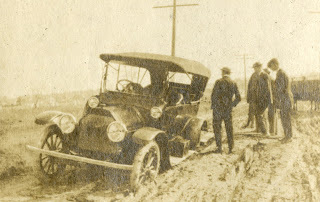I saw a picture recently of a Model T bogged in mud on Houston's South Main St. in 1915, somewhere near what was then called Rice Institute. It reminded me of a paragraph in Bob Armstrong's book, "Sugar Land, Texas and The Imperial Sugar Company." Here's the paragraph printed on page 87.
... an isolated community of 1,200 people in those days of less than reliable transportation, needed to be self-sufficient. Until 1927 brought at least a semblance of paved roads, Sugar Land was, to a considerable extent, an isolated community. Citizens could travel the twenty-eight miles to Houston or the seven miles to Richmond in a passenger coach often attached to a freight train; travel by buggy was slow but sure; and the automobiles of the 1920s often had difficulties with the roads available at the time. Sugar Land was connected to Houston by a narrow, high-centered two-lane road made of crushed shell and it was generally passable if a bit rough by today's standards. Going the other way to Richmond was seven miles of dirt road, rough but passable in dry weather. However, during wet weather it could be slick and doubtful or muddy and more doubtful, made passable only by local entrepreneurial farmers who waited by the deep mud holes with mule teams and hand lettered signs quoting the $.25 price for being pulled through. Many of the Model T drivers would plunge in, get bogged down and signal for help. It could
Model T bogged down on South Main St. near Rice University in 1915
(Photo from Rice History Corner blog)
happen several times to a driver determined to complete the trip. In Sugar Land, contemplating a trip to Richmond during the wet weather, a driver could call the telephone operator, who kept posted on such matters, to ask about the condition of the road, often to be told, "You can make it if you've got a pocket full of quarters."
I wish there were a photo of a farmer equipped with mules and hand-lettered sign.
